Introduction: A Master of Atmosphere
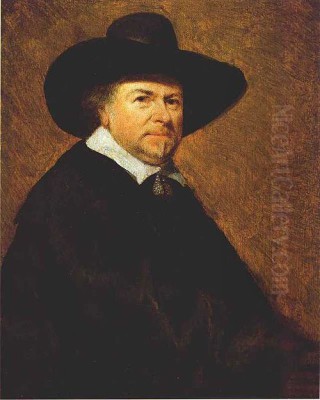
Jan van Goyen (January 13, 1596 – April 27, 1656) stands as one of the most significant and prolific landscape painters of the Dutch Golden Age. Born in Leiden, in the Netherlands, he rose from humble beginnings to become a defining figure in the development of naturalistic landscape art during the Dutch Baroque period. Van Goyen is celebrated for pioneering the "tonal" style of landscape painting, a revolutionary approach that emphasized atmosphere, mood, and the subtle interplay of light and air through a restricted, near-monochromatic palette. His vast body of work, encompassing paintings and drawings, captured the essence of the Dutch countryside, its waterways, and its skies, leaving an indelible mark on the history of art.
Early Life and Artistic Formation
Jan Josephsz. van Goyen was born into the family of a shoemaker in Leiden. His artistic inclinations surfaced early, and by the age of ten, he embarked on formal training. His initial apprenticeship years were marked by a restless search for the right guidance; remarkably, he studied under four different painters within just two years. This period of exploration suggests an early determination to find a path that resonated with his own developing vision. His journey eventually led him to Haarlem, a vibrant artistic center at the time.
In Haarlem, Van Goyen spent a crucial year studying under Esaias van de Velde, a highly respected landscape painter. Van de Velde's influence was profound and is clearly visible in Van Goyen's earlier works, which often featured brighter colours and more detailed, anecdotal scenes typical of the early 17th-century Dutch style. Esaias van de Velde was a key figure in the move towards greater realism in landscape painting, and his teachings undoubtedly provided Van Goyen with a solid foundation. Van Goyen also undertook travels, including a journey to France, which likely broadened his artistic horizons and exposed him to different landscapes and perhaps artistic approaches, further shaping his unique perspective.
The Emergence of the Tonal Style
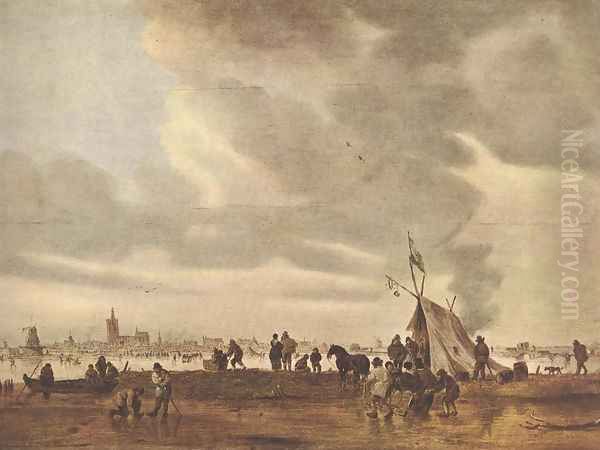
While his early works reflected the colourful, detailed style of his teacher Esaias van de Velde, Jan van Goyen's artistic voice truly emerged as he moved towards a more subdued and atmospheric approach. Around the late 1620s and increasingly through the 1630s, he began to develop what is now recognized as his signature "tonal" style. This marked a significant departure from the prevailing trends and represented a major innovation in Dutch landscape painting.
The tonal phase is characterized by a radically limited palette, dominated by subtle variations of browns, greys, and greens. Van Goyen masterfully used these restricted hues to evoke the damp, hazy atmosphere of the Dutch climate, capturing the effects of light filtering through clouds and reflecting off water. He simplified his compositions, often employing low horizons that allowed vast, expressive skies to dominate the canvas. Detail was subordinated to overall mood and the suggestion of depth and space. This approach created paintings that felt remarkably unified, harmonious, and imbued with a quiet, poetic realism.
This shift was not merely an aesthetic choice but also potentially an economic one. By using fewer pigments and working more rapidly, Van Goyen could produce paintings more efficiently, making his art accessible to a broader market within the burgeoning Dutch middle class. However, the artistic merit of this style was paramount; it allowed him to convey the specific character and feeling of the Dutch landscape with unprecedented sensitivity. His tonal works from the 1630s and 1640s are often considered the pinnacle of this phase, demonstrating his complete mastery of atmospheric effects.
Dominant Themes and Subjects
Jan van Goyen dedicated his artistic career almost exclusively to landscape. His deep connection to his native land is evident in the subjects he repeatedly depicted. He possessed an exceptional ability to observe and render the specific topography and atmosphere of the Netherlands. His works offer a comprehensive visual record of the Dutch environment in the 17th century.
River scenes and seascapes were among his most frequent subjects. He masterfully captured the interplay of water, sky, and land along the canals, estuaries, and coastal regions of Holland. Paintings like View of the Merwede River at Dordrecht showcase his skill in depicting bustling river traffic, expansive waters, and dramatic cloud formations. He rendered the reflections on the water and the sense of vast, open space with remarkable subtlety.
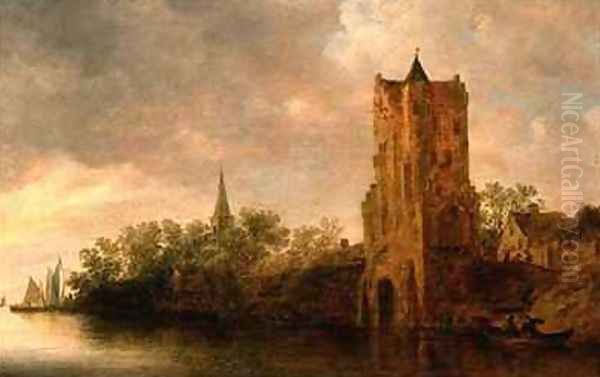
Winter landscapes also formed a significant part of his oeuvre. He depicted frozen canals alive with skaters and sleds, capturing the crisp air and unique light of the season. Village and town views were common, often featuring identifiable locations like Leiden, Haarlem, or his later home, The Hague. View of The Hague is a notable example, commissioned by the city council itself. Rural scenes, featuring farmhouses, windmills, and country roads under expansive skies, further demonstrate his commitment to portraying the everyday reality of the Dutch landscape. Through these varied themes, Van Goyen consistently emphasized the relationship between human activity and the natural environment.
Technique, Productivity, and Market Strategy
Jan van Goyen was an incredibly prolific artist. It is estimated that he produced over 1,200 paintings and more than 1,000 drawings during his career. This remarkable output was facilitated by his efficient painting technique. He often worked on wooden panels, applying paint thinly and rapidly, sometimes employing a "wet-on-wet" technique where layers of wet paint are applied onto previous wet layers. This method allowed for soft transitions and contributed to the atmospheric quality of his work.
His economical use of pigments, central to his tonal style, also enabled faster production. This combination of speed and limited materials made his paintings relatively affordable compared to the more elaborately detailed works of some contemporaries. Van Goyen seemed attuned to the art market; his stylistic evolution, including the introduction of different types of landscape views, can be seen partly as a strategy to maintain appeal among collectors. His signature on a work became a mark of quality, valued in auctions and inventories of the time.
His drawings, often executed in black chalk and grey wash, were not merely preparatory studies but finished works in their own right. They reveal his keen eye for observation and his ability to quickly capture the essence of a scene, often sketched directly from nature during his travels throughout the Netherlands. This vast output of both paintings and drawings cemented his reputation and ensured his widespread influence.
Life in The Hague: Professional Standing and Financial Woes
In 1631, Jan van Goyen made a significant move, relocating from Leiden and settling permanently in The Hague. He established his studio there and became a citizen in 1634. He married Annetie van Raelst in 1618, and they raised a family in The Hague. Professionally, Van Goyen achieved considerable recognition within the artistic community. He became the head (hoofdman) of The Hague Guild of Saint Luke, the city's painter's guild, in 1638 and again in 1640, a position reflecting his esteemed status among his peers. He also received prestigious commissions, such as the panoramic view of The Hague for the city hall.

Despite his artistic success and professional standing, Van Goyen's life was plagued by financial difficulties. He engaged in various business ventures outside of painting, including art dealing, property appraisal, and real estate speculation. Most notably, he invested heavily in tulip bulbs during the height of "Tulip Mania" in the 1630s. Like many others, he suffered significant losses when the speculative bubble burst.
These failed ventures led to mounting debts that troubled him for much of his later life. Records show that in 1652 and 1654, he was forced to sell significant portions of his own property and art collection, including paintings and prints by other artists, to satisfy his creditors. These financial struggles persisted until his death. Nevertheless, his commitment to his art remained unwavering, and his financial difficulties did not seem to diminish his artistic output or the quality of his work during these years.
Connections with Contemporaries: Rembrandt, Hobbema, and the Haarlem School
Jan van Goyen operated within a rich network of artists during the Dutch Golden Age. His initial training placed him firmly within the sphere of the Haarlem landscape tradition, heavily influenced by Esaias van de Velde. Other artists associated with this early move towards realism in Haarlem included Pieter de Molijn and Salomon van Ruysdael (uncle of the more famous Jacob van Ruisdael). Van Goyen's tonal innovations significantly influenced both De Molijn and Salomon van Ruysdael, who adopted similar palettes and atmospheric approaches in their own work.
His relationship with the towering figure of Rembrandt van Rijn is intriguing. While they worked in different primary genres (Rembrandt primarily in portraiture and history painting, Van Goyen in landscape), they were contemporaries whose paths likely crossed, especially given Van Goyen's activity as an art dealer and appraiser. Some sources suggest that Rembrandt himself recognized Van Goyen's talent and may have even drawn inspiration from Van Goyen's handling of light and atmosphere, particularly in Rembrandt's own landscape etchings and paintings. The presence of Van Goyen's works in contemporary collections, alongside those of Rembrandt, indicates their comparable status in the eyes of some collectors.
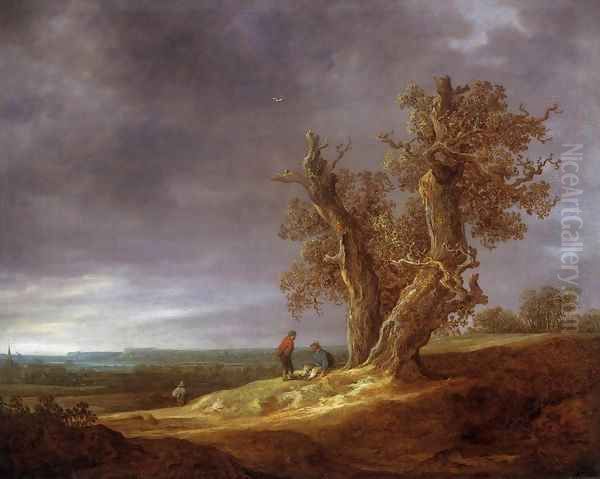
Meindert Hobbema, a later landscape painter often associated with Jacob van Ruisdael, represents the next generation but worked within the tradition that Van Goyen helped establish. While Hobbema's style is distinct, often more detailed and focused on woodland scenes, the foundation of naturalistic observation and attention to Dutch scenery owes a debt to pioneers like Van Goyen. Other contemporaries influenced by or connected to Van Goyen include Cornelis Vroom and Pieter Dircksz. van Santvoort (or perhaps Pieter Jansz. van Asch, as names can be confused in historical records). Van Goyen's position as head of the Hague Guild also placed him in direct contact with numerous local artists.
Enduring Influence and Legacy
Jan van Goyen's impact on the course of landscape painting was profound and lasting. His development of the tonal style represented a fundamental shift towards atmospheric naturalism, moving away from the more artificial conventions of earlier landscape art. This approach became a hallmark of Dutch landscape painting for several decades, influencing a generation of artists.
Directly influenced artists, besides Salomon van Ruysdael and Pieter de Molijn, include figures like Jan Coelenbier, Cornelis van Poelenburgh (though primarily known for Italianate scenes, some tonal influence might be discerned), Abraham van Beijeren (primarily a still-life painter, but part of the same artistic milieu), and Pieter Jansz. van Asch. These artists, and many others, absorbed Van Goyen's lessons in composition, palette, and the rendering of light and air. His efficient techniques were also widely adopted.
Beyond his immediate circle and successors in the 17th century, Van Goyen's emphasis on capturing the fleeting effects of light and atmosphere can be seen as anticipating later developments in landscape painting. His sensitivity to mood and his ability to convey the specific character of a place resonated with artists centuries later. Figures like the English Romantic painter J.M.W. Turner, known for his atmospheric seascapes and landscapes, and even the French Impressionists, who made the study of light and atmosphere central to their practice, arguably owe a conceptual debt to the groundwork laid by Dutch masters like Van Goyen.
Jan van Goyen died in The Hague on April 27, 1656, leaving behind substantial debts. His remaining possessions and unsold artworks were auctioned off to cover these liabilities. Despite his financial struggles during his lifetime, his artistic reputation endured and grew posthumously. Today, his works are held in major museums across the world, recognized for their historical importance and their quiet, evocative beauty. He remains celebrated as a key innovator who fundamentally shaped the way landscape was perceived and painted.
Conclusion: A Visionary of the Dutch Landscape
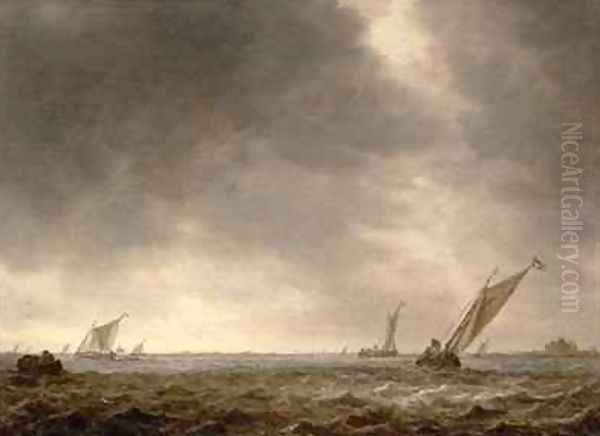
Jan van Goyen was more than just a prolific painter; he was a visionary who transformed landscape painting in the Dutch Golden Age. Through his pioneering tonal style, he captured the unique atmosphere and light of the Netherlands with unprecedented sensitivity and realism. His focus on simplified compositions, subdued palettes, and expansive skies allowed him to convey mood and space in a way that profoundly influenced his contemporaries, including Salomon van Ruysdael and Pieter de Molijn, and resonated through the history of art, touching even figures like Rembrandt and foreshadowing later movements. Despite personal financial hardship, his dedication to his craft resulted in a vast and cohesive body of work that stands as a testament to his innovative spirit and his deep understanding of the natural world. Jan van Goyen rightfully holds a crucial place as one of the founding fathers of Dutch landscape painting.